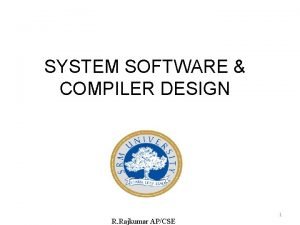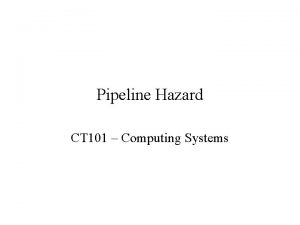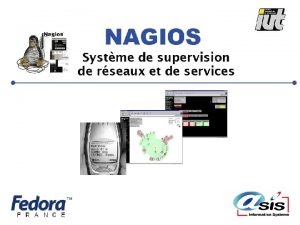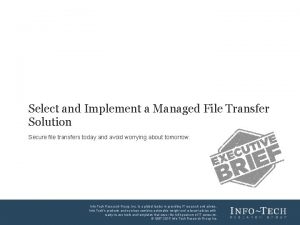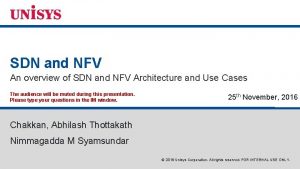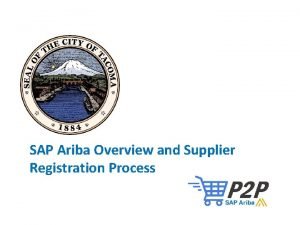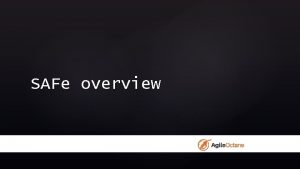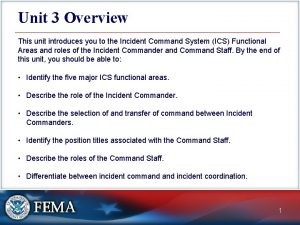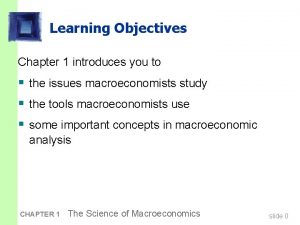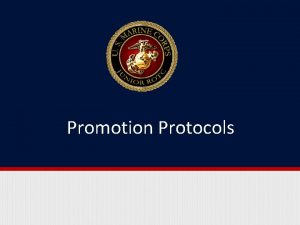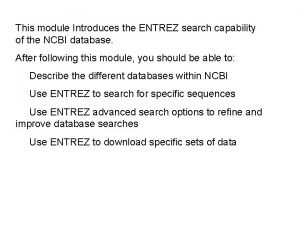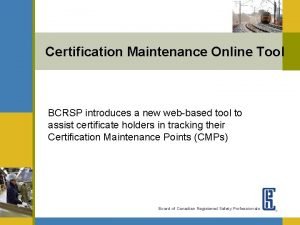Unit 3 Overview This unit introduces you to































- Slides: 31

Unit 3 Overview This unit introduces you to the Incident Command System (ICS) Functional Areas and roles of the Incident Commander and Command Staff. By the end of this unit, you should be able to: • Identify the five major ICS functional areas. • Describe the role of the Incident Commander. • Describe the selection of and transfer of command between Incident Commanders. • Identify the position titles associated with the Command Staff. • Describe the roles of the Command Staff. • Differentiate between incident command incident coordination. 1

ICS Functional Areas and Command Staff Roles Every incident requires that certain functional areas be implemented. The problem must be identified and assessed, a plan to deal with it must be developed and implemented, and the necessary resources must be procured and paid for. Regardless of the size of the incident, these functional areas are all required. In case you ever need to assist with an incident, you should understand how the management structure is constructed using the Incident Command System (ICS). This will help you understand your role in the structure and how you may receive information and assignments. This unit focuses on the five major functional areas and the Command Staff roles. The General Staff roles will be discussed in the next unit. 2

Five Major ICS Functional Areas There are five major Incident Command System (ICS) functional areas that are the foundation on which an incident management organization develops. These functions apply to incidents of all sizes and types, including both planned events and ones that occur without warning. If you are in an incident and hear these terms, its important for you to know what they mean. For instance, you may be directed to provide documents to the Planning Section or receipts to the Finance/Administration Section. 3

ICS Functional Area Descriptions Incident Command: Sets the incident objectives, strategies, and priorities, and has overall responsibility for the incident. Operations: Conducts operations to reach the incident objectives. Establishes tactics and directs all operational resources. Planning: Supports the incident action planning process by tracking resources, collecting/analyzing information, and maintaining documentation. Logistics: Arranges for resources and needed services to support achievement of the incident objectives (resources can include personnel, equipment, teams, supplies, and facilities). Finance/Administration: Monitors costs related to the incident. Provides accounting, procurement, time recording, and cost analyses. 4

Intelligence/Investigations Function in ICS 5

Review of Functional Areas (1 of 5) Which ICS Functional Area supports the incident action planning process by tracking resources, collecting/analyzing information, and maintaining documentation? 6

Review of Functional Areas (2 of 5) Which ICS Functional Area sets the incident objectives, strategies, and priorities, and has overall responsibility for the incident? 7

Review of Functional Areas (3 of 5) Which ICS Functional Area conducts operations to reach the incident objectives, establishes tactics, and directs all operational resources? 8

Review of Functional Areas (4 of 5) Which ICS Functional Area monitors costs related to the incident and provides accounting, procurement, time recording, and cost analyses? 9

Review of Functional Areas (5 of 5) Which ICS Functional Area arranges for resources and needed services to support achievement of the incident objectives? 10

ICS Structure 11

Incident Command Definition The National Incident Management System (NIMS) defines command as the act of directing, ordering, or controlling by virtue of explicit statutory, regulatory, or delegated authority. When you are using the Incident Command System (ICS) to manage an incident, an Incident Commander is assigned. The Incident Commander has the authority to establish objectives, make assignments, and order resources. To achieve these ends, the Incident Commander works closely with staff and technical experts to analyze the situation and consider alternative strategies. The Incident Commander should have the training, experience, and expertise to serve in this capacity. Qualifications to serve as an Incident Commander should not be based solely on rank, grade, or technical knowledge. 12

Incident Commander Lets begin by taking a closer look at the Incident Commander. The Incident Commander is responsible for the overall management of the incident. Overall management includes Command Staff assignments required to support the incident command function. The Incident Commander is the only position that is always staffed in ICS applications. On small incidents and events, one person-the Incident Commander-may accomplish all management functions. 13

Incident Commander Discussion Why is it critical to establish command from the beginning of an incident? 14

Incident Commander Responsibilities In addition to having the overall responsibility for managing the entire incident, the Incident Commander is specifically responsible for: • Ensuring overall incident safety • Providing information services to internal and external stakeholders, such as disaster survivors, agency executives, and senior officials • Establishing and maintaining liaisons with other agencies participating in the incident The Incident Commander may appoint one or more Deputies. If a Deputy is assigned, he or she should be fully qualified to assume the Incident Commanders position. 15

Selecting or Changing Incident Commanders The command function should be clearly established at the beginning of an incident. The jurisdiction or organization with primary responsibility for an incident designates the individual at the scene who is responsible for establishing command the protocol for transferring command. As an incident becomes more or less complex, command may change to meet the needs of the incident. When command is transferred, the process should include a briefing that captures all essential information for continuing safe and effective operations. 16

Transfer of Command Discussion The transfer of command process always includes a thorough transfer of command briefing, which may be oral, written, or a combination of both. It is also important to remember that the rest of the incident staff should be notified of the transfer of command. What would you include in a transfer of command briefing? 17

Deputy Incident Commander Discussion Scenario: The Deputy Incident Commander will be replacing the current Incident Commander, who needs to attend to a family emergency. What is the correct action for the Incident Commander? 18

Delegating Incident Management Responsibilities The Incident Commander only creates those sections that are needed. If a section is not staffed, the Incident Commander will manage those functions. 19

ICS Command Staff Depending upon the size and type of incident or event, the Incident Commander may designate personnel to provide information, safety, and liaison services. In the Incident Command System (ICS), the Command Staff may include: • Public Information Officer, who interfaces with the public and media and/or with other agencies with incident-related information requirements. • Safety Officer, who monitors incident operations and advises the Incident Commander on all matters relating to safety, including the health and safety of incident management personnel. • Liaison Officer, who serves as the Incident Commanders point of contact for representatives of governmental agencies, non-governmental organizations (NGOs), and private-sector organizations. Incident Commanders may also choose to appoint technical specialists (such as legal, medical, science and technology, or access and functional needs) to act as command advisors. The Command Staff reports directly to the Incident Commander. In a complex incident, Assistant Officers may be assigned to each of the Command Staff functions. 20

Command Staff Overview - Video 21

Command Staff Knowledge Check (1 of 3) Which member of the Command Staff is described below? "I work very closely with Operations to make sure that our people in the field are wearing appropriate protective equipment and implementing safe tactical options. " 22

Command Staff Knowledge Check (2 of 3) Which member of the Command Staff is described below? "I provide briefings to supporting Agency Representatives and work with them to address their questions and concerns about the operation. I remain visible on the incident scene to all incoming cooperating and assisting agencies. " 23

Command Staff Knowledge Check (3 of 3) Which member of the Command Staff is described below? "I am the primary contact for anyone who wants details about the incident and our response to it. I serve an external audience through the media and an internal audience including incident staff and agency personnel. " 24

Command Staff Roles - Activity 3. 1 Activity Purpose: To illustrate how ICS can be used to address incident management issues. Instructions: Working as a team: 1. Review the scenario presented on the next page of your Student Manual. 2. Identify which Command Staff positions would be assigned. 3. Next, if you were the Incident Commander, what specific activities would you delegate to each Command Staff member? 4. Select a spokesperson. Be prepared to present in 10 minutes. Time: 15 minutes Scenario: An unexpected flash flood has struck a small community. As a result: • Homes, schools, the business district, and the community college are being evacuated. • Damage to critical infrastructure includes contamination of the water supply, downed power lines, and damaged roads. • Perimeter control and security in the business district are needed. • Mutual aid is arriving from several surrounding communities. • Media representatives are arriving at the scene. 25

Incident Coordination Now that we've discussed the Command Staff roles, let's take a look at how the overall incident is coordinated. Coordination involves the activities that ensure the onsite Incident Command System (ICS) organization receives the information, resources, and support needed to achieve those incident objectives. Coordination takes place in a number of entities and at all levels of government. Examples of coordination activities include: • Establishing policy based on interactions with agency executives, other agencies, and stakeholders. • Collecting, analyzing, and disseminating information to support the establishment of shared situational awareness. • Establishing priorities among incidents. • Resolving critical resource issues. • Facilitating logistics support and resource tracking. • Synchronizing public information messages to ensure that everyone is speaking with one voice. 26

Command Coordination Effective incident management consists of four overarching areas of responsibility: 1. Direct tactical response to save lives, stabilize the incident, and protect property and the environment 2. Incident support through resource acquisition, information gathering, and interagency coordination 3. Policy guidance and senior level decision making 4. Outreach and communication with the media and public to keep them informed about the incident These objectives are accomplished through the use of the Incident Command System (ICS), Emergency Operations Centers (EOCs), Multi-agency Coordination (MAC) Groups, and the Joint Information System (JIS), respectively. 27

Emergency Operations Center Role Jurisdictions and organizations across the Nation use Emergency Operations Centers (EOCs) as an element of their emergency management programs. Typically, an Emergency Operations Center (EOC) supports the on-scene response by relieving the Incident Commander of the burden of external coordination and the responsibility for securing additional resources. An EOC is: • A physical or virtual location where staff from multiple agencies come together to address imminent threats and hazards • Staffed with personnel trained for, and authorized to, represent their agency/discipline • Equipped with mechanisms for communicating with the incident site • Providing support to the incident by obtaining resources • Applicable at different levels of government 28

Joint Information Center Another coordination entity is the Joint Information Center (JIC). The JIC: • May be established to coordinate all incident-related public information activities • Serves as the central point of contact for all news media-when possible, public information officials from all participating agencies should co-locate at the JICs may be established at various levels of government and at incident sites. Depending on your role in the incident, you may need to direct individuals or organizations to the JIC to obtain information. 29

Incident Command or Incident Coordination Do these statements represent Incident Command or Incident Coordination? 1. Establish objectives, make assignments, and order resources. 2. Collect, analyze, and disseminate information. 3. Synchronize public information messages. 4. Establish priorities among incidents. 30

Unit 3 Summary This unit introduced you to the: • Five major Incident Command System (ICS) Functional Areas. • ICS organizational structure. • Incident Commander roles and responsibilities. • Selection and transfer of Incident Commanders. • Command Staff roles and responsibilities. • Differences between incident command incident coordination. The next unit provides an introduction to the ICS General Staff Roles. 31
 Exposition elements
Exposition elements It introduces the characters and the setting
It introduces the characters and the setting Morgan ts
Morgan ts Language processor
Language processor Stalls
Stalls Jeep/eagle introduces a new product
Jeep/eagle introduces a new product How to write a informal email
How to write a informal email Do you love the rain
Do you love the rain Good health is a choice agree or disagree
Good health is a choice agree or disagree If you think you can you can poem
If you think you can you can poem Tell me what you eat and i shall tell you what you are
Tell me what you eat and i shall tell you what you are Wherever you may lead i will follow
Wherever you may lead i will follow Unit 6 review questions
Unit 6 review questions Www description
Www description Maximo overview
Maximo overview Universal modelling language
Universal modelling language Uml overview
Uml overview Vertical retailers
Vertical retailers Figure 12-1 provides an overview of the lymphatic vessels
Figure 12-1 provides an overview of the lymphatic vessels Overview of the major systemic arteries
Overview of the major systemic arteries Texas recapture districts
Texas recapture districts Walmart
Walmart Stylistic overview of painting
Stylistic overview of painting How can we integrate oop with sd/sa ?
How can we integrate oop with sd/sa ? Spring framework overview
Spring framework overview Nagios tactical overview
Nagios tactical overview Market overview managed file transfer solutions
Market overview managed file transfer solutions Sdn vs nfv
Sdn vs nfv Sbic program
Sbic program Sap consignment process
Sap consignment process Ariba overview
Ariba overview Safe overview
Safe overview



